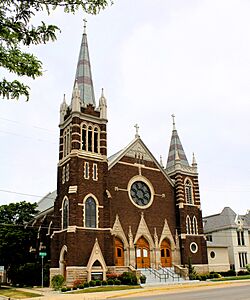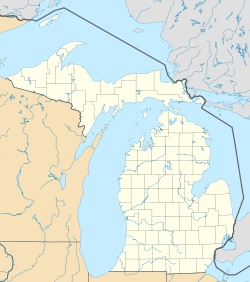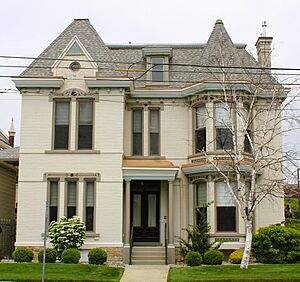Cathedral of Mary of the Assumption (Saginaw, Michigan) facts for kids
Quick facts for kids Cathedral of Mary of the Assumption |
|
|---|---|

The cathedral in 2023
|
|
| 43°25′33″N 83°56′12″W / 43.4258°N 83.9367°W | |
| Location | 615 Hoyt Ave. Saginaw, Michigan |
| Country | United States |
| Denomination | Roman Catholic Church |
| History | |
| Status | Cathedral/Parish church |
| Founded | 1853 |
| Dedicated | July 23, 1903 |
| Architecture | |
| Style | Gothic Revival |
| Groundbreaking | 1901 |
| Completed | 1903 |
| Specifications | |
| Capacity | 500 |
| Materials | Brick |
| Administration | |
| Diocese | Saginaw |
The Cathedral of Mary of the Assumption, often called St. Mary's Cathedral, is a Catholic church in Saginaw, Michigan. It serves as both a local parish church for its community and a cathedral, which is the main church for the entire Diocese of Saginaw.
Because of its historical importance, the cathedral is part of the Saginaw Central City Historic Residential District, which is listed on the National Register of Historic Places.
Contents
History of the Church
The story of this important church began over 150 years ago. It started as a small community and grew into the grand cathedral it is today.
Becoming St. Mary's Church
In 1853, St. Mary's was founded as a small mission. A mission is a church community that is just starting out. The first church building was dedicated that same year. Ten years later, a second, larger church was built.
By 1866, St. Mary's had grown enough to become its own parish, a stable church community with its own priest. The first school for the parish opened in 1868 in a small schoolhouse. Nuns from the Sisters, Servants of the Immaculate Heart of Mary came from Monroe to teach the children.
Over the next few years, the community grew and changed. New parishes were formed from St. Mary's for German, Polish, and French families. In 1874, the church helped start St. Mary's Hospital. A beautiful brick rectory, or home for the priests, was built in 1875 in a style called Châteauesque.
A new school, called St. Mary Academy, was built in 1878. The current church building, which is the third one for the parish, was built between 1901 and 1903. It was officially dedicated on July 23, 1903.
Becoming a Cathedral
A big change happened on February 26, 1938. That's when Pope Pius XI created the Diocese of Saginaw and chose St. Mary's Church to be its cathedral. A cathedral is the home church of a bishop and a center for the entire diocese (a large church region).
The building was updated several times. In 1941, it received a new altar (the table used for church services). A new home for the nuns, called a convent, was built in 1956.
A major renovation took place in 1978. The altar was moved closer to the people, and movable chairs replaced the old pews. A special chapel was created, and the organ and choir area were moved. The cathedral was re-dedicated on June 1, 1978.
Changes to the School and Campus
In the 1980s, several Catholic schools in the area joined together. St. Mary Cathedral School became part of a larger school system. Later, it merged with other high schools to form Nouvel Catholic Central High School. The old school building was sold in 1988.
By the 2000s, the diocese began to renew the entire cathedral campus. They bought back the old school building and the former convent. The old school was torn down in 2008, and the cathedral got a new roof.
The most recent major renovation happened in 2017. The cathedral closed for a $4.7 million project. The inside was rearranged, and it received a new marble altar, a speaker's stand called an ambo, and a baptismal font. It also got new wooden pews and an addition with new restrooms. The updated cathedral can now seat about 500 people.
The Cathedral's Pipe Organ
During the 2017 renovation, a special pipe organ was installed in the cathedral. The organ was originally built in 1930 by the Kilgen company for a church in Bay City, Michigan. It was rebuilt for the cathedral by a company from Otsego, Michigan.
This amazing instrument has about 1,800 pipes. It has two keyboards for the hands, called manuals, and a keyboard for the feet, called a pedalboard. This allows musicians to create a wide range of powerful and beautiful sounds.
See also
 In Spanish: Catedral de Santa María de la Asunción (Saginaw) para niños
In Spanish: Catedral de Santa María de la Asunción (Saginaw) para niños





